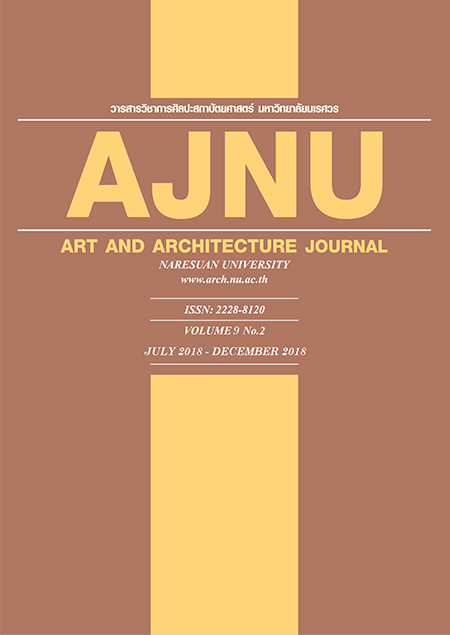Community Product Design and Development Applying the Cultural Capital and Wisdom : in the Upper Northeastern Region
Main Article Content
Abstract
This research is a qualitative and quantitative participatory action research conducted with participation
in communities. The objectives are 1) to study and compile the information on the cultural capital and wisdom
that can be applied to create community products and add value to them, 2) to find cultural identities that can
be applied in developing new products and 3) to design and develop products using cultural capital and wisdom.
The sample in this research is entrepreneurs of community industrial businesses/OTOP entrepreneurs of 22
enterprises pertaining to cloth and apparel, utensils, ornaments and souvenirs from the upper Northeastern
region, that is, Loei, Nong Khai, Nong Bua Lamphu, Bueng Kan and Udon Thani provinces. The sampling technique
used was purposive sampling. The tool used in the research was a questionnaire and the statistics used were the
means ( ) and standard deviations. For the research results, it is found that the cultural capital and wisdom that
can be applied to create community products and add value to them are those of the Ban Chiang cultural
heritage, Sri Kotrabun-Lan Chang cultural heritage and local cultural heritage. The researchers conducted a
search for cultural identities that can be applied in developing new products and categorized them into
types of applied patterns, such Ban Chiang, Sri Kotrabun-Lan Chang, Phu Thai and Tai Dam patterns.
Identities in faith cultures were also applied in innovative creation to suit products as seen in the pattern of
naga, which is in the faith culture of people in the area of the Mekong River basin, the pattern with the
theme of the Tale Nang Usa and Tao Baros, and so on. The entrepreneurs are classified by cultural capital
and wisdom into 3 groups. The first group consists of entrepreneurs of 7 enterprises who applied the Ban
Chiang cultural heritage in developing their products. The second group consists of entrepreneurs of 5
enterprises who applied the Sri Kotrabun-Lan Chang heritage in developing their products, and the third
group consists of entrepreneurs of 10 enterprises who applied the local heritage in developing their
products. For the result summary from the product evaluation by an expert using the questionnaire, it is
found that 21 enterprises are at the very good level ( = 4.57-5.00) and 1 enterprise is at the good level (
=
4.29). The recommendations on enhancement for each product vary, and from the evaluation of
satisfaction after the product development with all the 22 entrepreneurs, the satisfaction is at the very
good level (= 4.62).
Article Details
References
กระทรวงอุตสาหกรรม, กรมส่งเสริมอุตสาหกรรม, สำนักพัฒนาอุตสาหกรรมชุมชน. (2560). ขอบเขตการดำเนินงานจ้างที่ปรึกษา(Terms of Reference : TOR) (CAW 01/2560) เพื่อดำเนินงานพัฒนาธุรกิจอุตสาหกรรมโดยใช้ทุนทางวัฒนธรรมและภูมิปัญญา ภายใต้โครงการพัฒนาธุรกิจอุตสาหกรรมโดยใช้ทุนทางวัฒนธรรมและภูมิปัญญา. เอกสารอัดสำเนา.
เกรียงศักดิ์ เจริญวงศ์ศักดิ์. (16 พฤศจิกายน 2559). ประเทศไทย 4.0 กับทุนทางวัฒนธรรม. สืบค้นเมื่อ 20 มกราคม 2561,จาก http://www.bangkokbiznews.com/blog/detail/639453.
ลัดดาวัลย์ เพชรโรจน์ และอัจฉลา ชำนิประศาสน์. (2547). ระเบียบวิธีวิจัย. กรุงเทพฯ : ดีการพิมพ์.
นฤตม์ เทอดสถีรศักดิ์. (2550). Global village : มหัศจรรย์แห่งหมู่บ้านหลังเขา พอเพียงและยั่งยืนท่ามกลางกระแสโลกาภิวัฒน์. กรุงเทพฯ: แบรนด์เอ้ดท์.
บ้านจอมยุทธ. (ม.ป.ป.). เกร็ดความรู้ จากสารานิกรมไทย, สืบค้นเมื่อ 20 มกราคม 2561,จาก https://www.baanjomyut.com/library/knowledge.
ประทับใจ สิกขา. (2552). ผ้าในวิถีชีวิตไทดำ. อุบลราชธานี : โรงพิมพ์มหาวิทยาลัยอุบลราชธานี.
ประทับใจ สิกขา. (2554). ผ้าทอผู้ไทย. อุบลราชธานี: โรงพิมพ์มหาวิทยาลัยอุบลราชธานี.
พรสนอง วงศ์สิงห์ทอง. (2559). ประวัติศาสตร์การออกแบบอุตสาหกรรม. กรุงเทพฯ: โอเดียนสโตร์.
ศูนย์ข้อมูลมรดกโลก, กระทรวงวัฒนธรรม. “แหล่งมรดกโลกบ้านเชียง” สืบค้นเมื่อ 6 พฤศจิกายน 2559, จาก http://www.thaiwhic.go.th/heritage_culture3.aspx.
ศิริวรรณ วิบูลย์มา. (2556). การติดตามประเมินผลการดำเนินงานตามโครงการแผนชุมชนพึ่งตนเองตามแนวปรัชญาเศรษฐกิจพอเพียงของกรุงเทพมหานคร กรณีศึกษาชุมชนแออัดบุญเหลือ 2 เขตบางซื่อ. วารสารศรีนครินทรวิโรฒและพัฒนา (สาขามนุษยศาสตร์และสังคมศาสตร์), 5(10), 92-104.
องค์การบริหารส่วนจังหวัดนครพนม. (21 พฤษภาคม 2560). อาณาจักรศรีโคตรบูรณ์. สืบค้นเมื่อ 20 มกราคม 2561,จาก http://nkpao.go.th/index.php?name=blog&file=readblog&id=23.
อรัญ วานิชกร. (2559). การออกแบบผลิตภัณฑ์ท้องถิ่น. กรุงเทพฯ: สำนักพิมพ์แห่งจุฬาลงกรณ์มหาวิทยาลัย.


